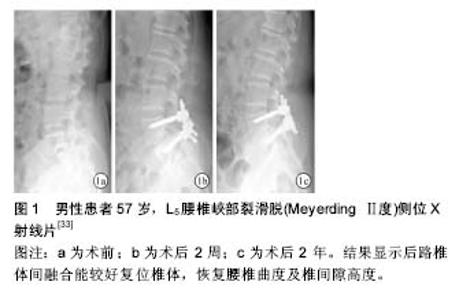Chinese Journal of Tissue Engineering Research ›› 2017, Vol. 21 ›› Issue (27): 4423-4428.doi: 10.3969/j.issn.2095-4344.2017.27.027
Advance in the treatment of lumbar spondylolysis
Wang Zheng1, Sun Tian-sheng2
- 1Shanxi Medical University, Taiyuan 030001, Shanxi Province, China; 2General Hospital of Chinese PLA, Beijing 100700, China
-
Online:2017-09-28Published:2017-10-24 -
Contact:Sun Tian-sheng, Chief physician, Doctoral supervisor, General Hospital of Chinese PLA, Beijing 100700, China -
About author:Wang Zheng, Master, Shanxi Medical University, Taiyuan 030001, Shanxi Province, China
CLC Number:
Cite this article
Wang Zheng, Sun Tian-sheng. Advance in the treatment of lumbar spondylolysis[J]. Chinese Journal of Tissue Engineering Research, 2017, 21(27): 4423-4428.
share this article

2.1 峡部裂的诊断 腰椎峡部裂、腰椎下部的局部骨缺损,终会导致该阶段腰椎单侧或双侧椎弓的裂隙。长此以往致患椎双侧峡部完全缺损时,椎弓崩裂会导致腰椎滑脱,此时椎体、椎弓根、横突和上关节突一起与椎板、棘突和下关节突间发生分离。目前确诊主要依赖于影像学检查,包括X射线腰椎正侧位、斜位、腰椎CT,及腰椎MRI。 屈国林等[4]通过研究表示传统X射线正侧位摄片很难清晰的显示峡部断裂处,而腰椎左右斜位片一度被认为峡部裂的确诊标准,因45°左右斜位片,可清楚的显示腰椎峡部的纵行或斜形裂隙。但因左右斜位片在拍摄时达不到与峡部切线平行,继而导致左右侧斜位片只能显示约15%的峡部缺损及骨折,漏诊率最高可达85%。正侧位片出现腰椎峡部上下缘连续性中断及低密度影时,可作为判断腰椎峡部裂的重要证据。正侧位片显示椎弓根下出现原有结构的改变及高密度影,以及正位片出现“裂隙征”时,可作为诊断腰椎峡部裂的重要原则。相比左右斜位片检查,CT由于除外了临近肌肉组织对骨性结构显影的影响,能更加清楚的显示腰椎峡部裂的具体细节,因此显著降低了腰椎峡部裂的漏诊率。 有研究论证了CT 较平片更能提供关于腰椎峡部形态上的改变和病因的情况[5]。而腰椎MRI可以较早的探测峡部信号的改变[6]。其优势在于无创伤、无辐射,是青少年患者和孕期妇女的首选检查;此外MRI可进行多方位、多平面的影像学成像,提高了针对软组织的分辨率,最大限度的弥补X射线、CT单一断面成像为主的的不足;同时MRI具有良好的空间分辨率,矢状位成像可更加直观的显示椎弓峡部、上下关节突及椎板的损伤情况,尤其是针对腰椎峡部裂常见的椎弓后部移位,MRI可更加清晰的显示上下椎体间的位置关系[7]。腰椎峡部裂患者治疗的目的在于缓解疼痛和恢复功能。因此,对于仅有影像学改变却无明显临床症状的腰椎峡部裂患者无需特殊处理。 2.2 峡部裂的治疗 在临床上,腰椎峡部裂的治疗大体上可分为保守治疗和手术治疗。治疗的目的都是改善患者临床表现,恢复患者日常功能。通常通过制动、加压植骨、内固定器等方法使断裂的峡部骨性愈合,恢复原有结构。近年来临床上对腰椎峡部裂患者采取保守治疗或是手术治疗,以及手术方式的选择等,尚存在争议。 2.2.1 保守治疗 保守治疗可以使大多数的腰椎峡部裂患者缓解或消除单纯的下腰疼等症状,因此保守治疗被大部分学者认为是一种行之有效的治疗方法。 Frennered等[8]通过7年的的随访研究腰椎峡部裂,发现只有极少部分患者进一步发展,绝大部分患者无需手术治疗。通过对436例确诊腰椎峡部裂并有症状的青少年进行回顾性分析表明,采取3-6个月的佩戴胸腰支具、限制活动辅以理疗,95%患者腰背疼痛症状缓解[9]。保守治疗的适应证多为:患者病程相对短、除慢性下腰痛外无其他临床表现、轻度滑脱及年龄较大、体质差不能耐受手术治疗或伴有严重基础疾病的患者。保守治疗的方法包括长期卧床休息、限制日常活动,加强腹部及腰背部肌肉训练,避免腰椎过屈过伸,维持躯干稳定性锻炼,佩戴胸腰支具3-6个月,同时辅以热敷等物理治疗,如有必要时可在门诊医生指导下,按需口服非类固醇抗炎镇痛药。各种保守治疗的目的是减少对病变峡部的异常应力,从而减少局部的异常活动,为峡部的纤维及骨性愈合提供良好的前提。有学者认为腰椎峡部裂的患者,经过保守治疗后症状缓解率明显高于峡部骨性愈合率,故认为腰椎峡部裂的纤维愈合在临床上是可以接受的[9]。Sairyo等[10]研究发现年轻峡部裂患者在不同时期采取保守治疗后峡部愈合率是不同的,早期腰椎峡部裂经过保守治疗后愈合率可达到87%;随着病程的延长,中期的愈合率骤降至32%;而晚期的愈合率几乎为0,由此可见对于腰椎峡部裂患者来说,越早的采取保守治疗,其效果也是越好的。 2.2.2 手术治疗 尽管多数腰椎峡部裂患者采取正规的内科保守治疗后,一定程度上都有症状的缓解,甚至治愈。若通过严格的内科保守治疗6个月以上仍有持续性腰痛或反复复发及出现神经根症状,同时在影像学上发现病变椎体有滑脱的倾向,或已具备一定的腰椎管狭窄症、腰椎间盘突出症的临床表现则需要考虑手术治疗。也有学者认为只有少数的腰椎峡部裂患者[11],经过卧床休息、限制活动、佩戴胸腰支具以及系统的内科保守治疗能达到活动治愈,即骨性愈合,因此主张早期行手术治疗。目前世界范围内治疗腰椎峡部裂的手术方式繁多(表1),但无论用何种术式,手术治疗的根本是使峡部裂达到骨性愈合,最终的目的是使患者临床症状消失。 "


椎峡部裂的局部植骨融合术,该术式的方法采取腰后路暴露患椎峡部,用骨凿将峡部的纤维骨痂、硬化骨清除干净,清除骨断端纤维组织,取自体髂骨局部植骨,术后患者卧床休息,辅以石膏腰围外固定,3个月后佩戴简易腰围维持固定同时下床活动。杨建东等[13]研究采取自体髂骨植骨治疗单纯腰椎峡部裂,发现该术式对人体正常生理解剖结构改变小,不需植入任何异体元素,操作简单,创伤小,且均获得骨性愈合,但Kant等[14]研究发现对峡部裂患者实施单纯峡部植骨术后假关节的发生率为25%。此术式因未解决脊柱不稳定及未消除剪切力,所以临床医生采取该术式应严格把握适应证。有学者认为该术式的适应证[15]:①仅为单纯腰椎峡部裂,无腰椎滑脱及其他脊柱疾患(即使轻度滑脱,也反映有一定程度的椎间盘退变,有滑脱、不稳的倾向);②适应于青少年,年龄不能超过30岁。该术式术后必须长期卧床,并可能导致医源性椎管狭窄及融合处假关节形成,近年来临床应用较少。 Buck峡部螺钉固定法:Buck[16]于1970年提出在峡部植骨的基础上,同时在峡部不连处以螺钉贯穿的手术方法。采用3.5-4.0 mm的皮质骨螺钉或类似螺钉作为拉力螺钉在C型臂透视定位下直接打入峡部断裂处,并于峡部植骨。该术式在临床及随后的随访中取得良好的效果,打开了脊柱节段内固定的大门。使用螺钉从椎板直接贯穿断端的峡部,旨在恢复峡部的连续性,垂直于断端峡部,对不连处有较好加压作用,符合生物力学原理,加速促进断端的骨性愈合。该术式的优势在于解剖结构简单、对患者的创伤小、出血量少,术后患者恢复好,可以更快的获得骨性愈合。Ohmori等[17]研究在使用Buck法治疗31例患者中通过随访发现其术后优良率为90.3%,有2例仍留有峡部裂缝,未达到骨性愈合。Menga等[18]使用Buck法临床研究发现90%的患者取得良好的临床疗效。此术式目前仍存在一定的缺陷,由于腰椎峡部裂的两端通常相对圆钝且光滑,并且有很大可能性伴有硬化现象的发生[19]。为了术中尽可能多的清理峡部断裂区域的骨化增生组织,清理后难免遗留相应的缺损长度。使用螺钉加压固定可造成病变节段于邻近节段上下关节突咬合关系发生紊乱,从而引起患者术后疼痛。另外,还存在螺钉加压过程中短缩峡部,容易导致螺钉的松脱的可能,此外螺钉直接贯穿峡部,使细长的峡部所能容纳的植骨量有限,对断端峡部的愈合有一定影响。由于人种的区别,欧美人群比亚洲人群普遍存在腰椎峡部宽大,更能适应Buck法。故腰椎峡部细小或畸形是其禁忌证。 Scott横突棘突间钢丝捆绑法:Nicol等[20]于1977年率先提出该术式,该术式是将不锈钢钢丝绕过两侧横突根部,再使钢丝穿过棘突下缘,将分离的椎板和椎体捆绑在一起。钢丝固定可促进峡部断裂处骨性愈合,恢复腰椎峡部正常解剖结构的连续性和生理功能。峡部裂所在节段的固定的方法主要是在患椎横突前方和棘突下方缠绕钢丝予以固定。为促进峡部断裂处薄弱部分的愈合,术中对峡部断裂处周围进行植骨,以强化患椎椎板和上关节突间的联合。成茂天等[21]在采用Buck峡部螺钉固定并植骨术治疗腰椎峡部裂患者后,再加以钢丝在峡部裂椎体的两侧横突根部捆绑并交叉于棘突下,并取髂骨行峡部断裂处自体骨植骨,后经过生物力学测验,Scott钢丝捆绑法与Buck峡部螺丝钉法所取得的临床优良率为94.4%和92.8%,均达到满意的效果。该术式的不足之处在于需要充分暴露横突,在显露过程中造成的创伤较大,可能导致血管及神经的副损伤,捆绑过程应力分散不均易造成横突根部骨折,这也是该手术失败常见的原因,另一方面由于使用钢丝固定有可能随着时间延长、或患者术后的功能性锻炼,引起钢丝松动、位置改变,继而导致手术的失败。Johnson等[22]报道22例Scott法术后疗效,仅17例融合成功,5形例形成假关节。 椎弓根钉-椎板钩固定法:Morscher等[23]于1984年率先使椎弓根钉-椎板钩固定法修复腰椎峡部裂。术中于病椎打入2枚椎弓根螺钉,后在病椎的椎板下缘插入椎板钩,在峡部断端植入自体骨后加压椎板钩并与椎弓根螺钉锁定,这样能使峡部断端与植入骨紧密接触、减少断端活动,从而有利于骨断端融合。周忠杰等[24]通过研究发现为了获得满意的临床治疗效果,手术操作过程应小心谨慎并注意以下要素:①术中必须确切的清除峡部断裂发展过程中所产生的瘢痕组织和峡部裂断端硬化的骨质,清理出的植骨床应至骨面有些许渗血为好。植骨面积应足够大,峡部断端植入自体松质骨后通过椎弓根螺钉-椎板钩进一步加压固定,同时联合峡部断裂处后外侧植骨,提高此术式的融合成功率;②注意术中应尽量微创操作,保护椎旁肌和关节囊,尽最大可能消除术后发生的慢性下腰痛及由于内固定所产生的腰椎结构不稳。该术式有可在峡部植入可观的骨量、暴露少,创伤小、固定强度高等优点已被国内外学者广泛运用并取得不错的疗效。Shin等[25]应用此法治疗23例腰椎峡部裂患者,其中18例获得骨性融合。运用此法治疗28例青少年腰椎峡部裂患者,均取得良好的疗效[26],无内固定断裂、松动等并发症。其他类似该术式的有椎弓根螺钉结合U型棒植骨内固定和椎弓根螺钉V型棒植骨内固定[27-28]。都取得了显著的疗效。 记忆合金节段内固定法:镍钛形态记忆合金是一种新型的生物功能材料,又被成为记忆合金。因其良好的生物相容性及耐磨、耐疲等特性,受到医学界广泛的关注,开启了临床运用生物功能材料的新篇章。朱立新等[29]对镍钛形态记忆合金在临床中具体应用的可行性做出了3类生物力学测试:即稳定性测试、强度测试和疲劳测试。其研究结果表明镍钛形态记忆合金内固定器能够显著改善峡部裂腰椎的稳定性,并且与传统材质所制成的内固定无显著性差异。应用该生物材料内固定可以对患者峡部持续加压,形成有效的弹性固定,并且随着术后功能性康复锻炼而加大内固定力。记忆合金材料内固定操作方便,冰水浸泡后塑性简单,待植入患者体内后,随着温度升高产生巨大的恢复力,能将椎体和椎板固定牢靠,同时术中植入的异体骨块也将受力而压向峡部,无需另行固定。张辉等[30]研究使用该生物材料内固定治疗腰椎峡部裂23例的效果,用Henderson标准评估临床疗效,治疗效果的优良率达到95.65%,断端的融合率达97.56%,在术后的随访过程未发现该生物材料断裂、松动等并发症。周松初和肖文德等[31]对该生物材料内固定器通过生物力学析和有限元分析,证明该生物材料内固定基本符合人体解剖特征和应力分布且抗压性强,可达到坚强固定腰椎峡部裂节段。 节段间融合术:20世纪40年代Ralph Cloward率先提出后路腰椎融合术,该技术发展至今已成为脊柱外科基本术式之一,该术式多运用于腰椎峡部裂患者合并Ⅱ度或Ⅱ度以上腰椎滑脱,由于在植骨融合的同时可椎板减压,故适应于腰椎峡部裂,同时合并有椎管狭窄、神经根、脊髓受压及椎间盘突出的患者。荆兴泉等[32]经过大量的临床手术及术后随访后发现该术式优点为:腰椎后路生理结构累及少,其支撑点更加接近椎体中柱,内固定器所产生的应力强,对于已经发生滑脱的椎体有显著的复位效果,且患者在术后可早期下床;对于合并滑脱的患者,术中可同时实施植骨融合术,该治疗能有效维持腰椎生理前凸及腰椎生物力学特性,给予椎间足够的纵向支撑效果;能明显去除椎间盘间隙的反常运动,适当缓解椎间盘源性疼痛症状,同时最大限度恢复椎间盘的原有高度。与此同时,该术式的不足之处在于融合后邻近节段的活动度将大幅下降,加速了腰椎邻近节段的退变。有研究表明椎间植骨融合内固定术已经大范围的应用于治疗腰椎峡部裂,并且在临床和随访中都取得良好的效果。赵超和孙天威等[33]通过对比研究发现腰后路椎间植骨融合治疗腰椎峡部裂不仅能恢复腰椎生理曲度及椎间隙高度,而且植骨融合率也较高,能维持脊柱力学稳定性,远期效果佳(图1)。王建顺等[34]研究该术式治疗腰椎峡部裂,患者术后开始功能锻炼和远期日常活动中都取得了满意的效果。"


微创治疗:随着微创技术的日益发展,以及患者对治疗要求的不断提高,小切口的微创治疗不断应用于临床。丁金勇等[35]通过25例微创手术与31例传统开放手术的疗效发现随着技术的更新与进步,微创手术为腰椎峡部裂患者的治疗带来了更快捷、更安全、更有效的方法,这样根据患者的临床症状与体征、影像学所体现的腰椎峡部断裂程度,就可以依据不同方式、方法的微创操作系统有选择地进行经皮内固定以及椎间融合。传统的开放手术由于术中需逐层剥离软组织至峡部,破坏脊柱后柱结构、椎旁肌肉及对关节突的广泛剥离,影响了脊柱的稳定性,内固定的植入改变了原有的解剖结构,易造成术后慢性下腰痛[36]。此腰痛多与损伤支配椎旁多裂肌的脊神经后支有关,导致神经出现不可逆损伤[37]。小切口的微创治疗较传统开放术式的优势在于对周围组织损伤小、出血少、术后愈合更快、临床效果良好等。因此越来越来受到患者的青睐。Higashino等[38]在Buck法的基础上结合椎间孔镜治疗3例腰椎峡部裂,术后腰背痛完全缓解及未出现各种并发症。但微创治疗也有其局限性,如合并有椎间盘退变,Ⅱ度以上的腰椎滑脱,腰椎间盘突出症、腰椎管狭窄症等均不适宜微创治疗。"

| [1] Kalichman L, Kim DH, Li L, Guermazi A,et al. Spondylolysis and spondylolisthesis: prevalence and association with low back pain in the adult community-based population. Spine. 2009;34(2):199-205.[2] Mora-de Sambricio A,Garrido-Stratenwerth E.[Spondylolysis and spondylolisthesis in children and adolescents].Revista espanola de cirugia ortopedica y traumatologia.2014;58(6):395-406.[3] Leone A, Cianfoni A, Cerase A,et al. Lumbar spondylolysis: a review. Skeletal radiology. 2011;40(6):683-700.[4] 屈国林,金青松,腾树春,等.腰椎峡部裂X线诊断的新征象—腰椎峡部上下缘连续性中断[J]. 海南医学. 2011,22(6):14-17.[5] Stabler A, Paulus R, Steinborn M,et al. [Spondylolysis in the developmental stage: diagnostic contribution of MRI]. RoFo: Fortschritte auf dem Gebiete der Rontgenstrahlen und der Nuklearmedizin. 2000;172(1):33-37.[6] Udeshi UL, Reeves D. Routine thin slice MRI effectively demonstrates the lumbar pars interarticularis[J]. Clinical radiology. 1999;54(9):615-619.[7] 张红辰,王艳芝,李国新,等.滑脱前期腰椎峡部裂的常规X线、CT和MRI检查的诊断价值比较[J].河北医药. 2014,36(14) 2146-2147.[8] Frennered AK, Danielson BI, Nachemson AL. Natural history of symptomatic isthmic low-grade spondylolisthesis in children and adolescents: a seven-year follow-up study. J Pediatr Orthop. 1991;11(2):209-213.[9] Hu SS, Tribus CB, Diab M,et al.Spondylolisthesis and spondylolysis. J Bone Joint Surg Am. 2008;90(3):656-671.[10] Sairyo K, Sakai T, Yasui N,et al.Conservative treatment for pediatric lumbar spondylolysis to achieve bone healing using a hard brace: what type and how long?: Clinical article. J Neurosurg Spine. 2012;16(6):610-614.[11] Fujii K,Katoh S,Sairyo K,et al.Union of defects in the pars interarticularis of the lumbar spine in children and adolescents. The radiological outcome after conservative treatment. J Bone Joint Surg Br. 2004;86(2):225-231.[12] Kimura M. My method of filing the lesion with spongy bone in spondylolysis and spondylolistesis. Seikei Geka. 1968;19(4): 285-296.[13] 杨建东,贾连顺,李家顺,等.峡部植骨治疗单纯腰椎椎弓峡部裂[J]. 中国矫形外科杂志. 2004,12(6):9-10.[14] Kant AP, Daum WJ, Dean SM,et al.Evaluation of lumbar spine fusion. Plain radiographs versus direct surgical exploration and observation.Spine. 1995;20(21):2313-2317.[15] Chen JF, Lee ST. A physiological method for the repair of young adult simple isthmic lumbar spondylolysis. Chang Gung Med J. 2000;23(2):92-98.[16] Buck JE. Direct repair of the defect in spondylolisthesis. Preliminary report J Bone Joint Surg Br. 1970;52(3):432-437.[17] Ohmori K, Suzuki K, Ishida Y. Translamino-pedicular screw fixation with bone grafting for symptomatic isthmic lumbar spondylolysis.Neurosurgery. 1992;30(3):379-384.[18] Menga EN, Kebaish KM, Jain A,et al. Clinical results and functional outcomes after direct intralaminar screw repair of spondylolysis. Spine. 2014;39(1):104-110.[19] 许旻鸣,潘汉升.非椎间融合内固定治疗峡部裂性腰椎轻度滑脱进展[J]. 大众科技. 2015,(7):89-91+4.[20] Nicol RO, Scott JH. Lytic spondylolysis. Repair by wiring. Spine. 1986;11(10):1027-30.[21] 成茂华,唐天驷,郑祖根,等.经峡部内固定治疗腰椎峡部裂及其生物力学实验研究[J]. 中国脊柱脊髓杂志. 1997,7(2):60-63.[22] Johnson GV, Thompson AG. The Scott wiring technique for direct repair of lumbar spondylolysis. J Bone Joint Surg Br. 1992;74(3):426-430.[23] Morscher E, Gerber B, Fasel J. Surgical treatment of spondylolisthesis by bone grafting and direct stabilization of spondylolysis by means of a hook screw. Arch Orthop Trauma Surg. 1984;103(3):175-178.[24] 周忠杰,宋跃明,曾建成,等.节段内椎弓根螺钉-椎板钩系统固定治疗腰椎峡部裂疗效观察[J]. 中国修复重建外科杂志. 2013, 27(3):274-277.[25] Shin MH, Ryu KS, Rathi NK, et al. Direct pars repair surgery using two different surgical methods : pedicle screw with universal hook system and direct pars screw fixation in symptomatic lumbar spondylosis patients. J Korean Neurosurg Soc. 2012;51(1):14-19.[26] 刘海潮,李存孝,范德刚,等.椎弓根复合体钉钩系统治疗青年腰椎峡部裂[J].中华全科医学. 2013,11(7): 1007-1008,1043,封3页.[27] 蒲小兵,杨双石,曹海泉,等.采用U形钛棒固定系统的节段内固定与峡部植骨治疗青壮年腰椎峡部裂[J]. 中国修复重建外科杂志. 2014,28(3):354-357.[28] Gillet P, Petit M. Direct repair of spondylolysis without spondylolisthesis, using a rod-screw construct and bone grafting of the pars defect.Spine. 1999;24(12):1252-1256.[29] 朱立新,李善会,宋钦勇,等.腰椎峡部裂机翼型记忆合金节段内固定器的生物力学评价[J].中国临床解剖学杂志, 2013,31(3): 332-336.[30] 张辉,靳安民,童斌辉,等.腰椎峡部裂记忆合金节段内固定器的临床应用[J].中国矫形外科杂志. 2003(10):13-15.[31] 周初松,肖文德,张效三,等. 腰椎峡部裂翼状记忆合金节段内固定器的研制[J]. 脊柱外科杂志. 2006,4(1):33-37.[32] 荆兴泉,杨双石,龙跃兵. 军人腰椎峡部裂的原因分析与治疗策略[J]. 西南国防医药,2014,24(2):166-168.[33] 张超,孙天威,田融,等.两种手术方式治疗峡部裂型腰椎滑脱症的对比研究[J].中国修复重建外科杂志,2015,29(2):179-183.[34] 王建顺,王新虎,刘继军,等. 椎弓根螺钉内固定结合椎体间植骨术治疗腰椎滑脱症的疗效观察[J]. 中国骨与关节损伤杂志. 2008,23(8):669-670.[35] 丁金勇,刘涛,周跃,钱莘.微创和开放手术治疗腰椎峡部裂滑脱的疗效分析[J]. 中国骨与关节损伤杂志,2009,24(8):687-690.[36] 孙海东.后路椎弓根钉棒内固定系统联合椎间植骨融合治疗腰椎滑脱分析[J]. 中国医学创新. 2013,9(2):125-126.[37] [Suwa H, Hanakita J, Ohshita N,et al. Postoperative changes in paraspinal muscle thickness after various lumbar back surgery procedures.Neurologia medico-chirurgica.2000,40(3): 151-154; discussion 4-5.[38] Higashino K, Sairyo K, Katoh S,et al. Minimally invasive technique for direct repair of the pars defects in young adults using a spinal endoscope: a technical note. Minim Invasive Neurosurg. 2007;50(3):182-186. |
| [1] | Yao Xiaoling, Peng Jiancheng, Xu Yuerong, Yang Zhidong, Zhang Shuncong. Variable-angle zero-notch anterior interbody fusion system in the treatment of cervical spondylotic myelopathy: 30-month follow-up [J]. Chinese Journal of Tissue Engineering Research, 2022, 26(9): 1377-1382. |
| [2] | An Weizheng, He Xiao, Ren Shuai, Liu Jianyu. Potential of muscle-derived stem cells in peripheral nerve regeneration [J]. Chinese Journal of Tissue Engineering Research, 2022, 26(7): 1130-1136. |
| [3] | Zhang Jinglin, Leng Min, Zhu Boheng, Wang Hong. Mechanism and application of stem cell-derived exosomes in promoting diabetic wound healing [J]. Chinese Journal of Tissue Engineering Research, 2022, 26(7): 1113-1118. |
| [4] | Chen Xiaoxu, Luo Yaxin, Bi Haoran, Yang Kun. Preparation and application of acellular scaffold in tissue engineering and regenerative medicine [J]. Chinese Journal of Tissue Engineering Research, 2022, 26(4): 591-596. |
| [5] | Kang Kunlong, Wang Xintao. Research hotspot of biological scaffold materials promoting osteogenic differentiation of bone marrow mesenchymal stem cells [J]. Chinese Journal of Tissue Engineering Research, 2022, 26(4): 597-603. |
| [6] | Shen Jiahua, Fu Yong. Application of graphene-based nanomaterials in stem cells [J]. Chinese Journal of Tissue Engineering Research, 2022, 26(4): 604-609. |
| [7] | Zhang Tong, Cai Jinchi, Yuan Zhifa, Zhao Haiyan, Han Xingwen, Wang Wenji. Hyaluronic acid-based composite hydrogel in cartilage injury caused by osteoarthritis: application and mechanism [J]. Chinese Journal of Tissue Engineering Research, 2022, 26(4): 617-625. |
| [8] | Li Hui, Chen Lianglong. Application and characteristics of bone graft materials in the treatment of spinal tuberculosis [J]. Chinese Journal of Tissue Engineering Research, 2022, 26(4): 626-630. |
| [9] | Gao Cangjian, Yang Zhen, Liu Shuyun, Li Hao, Fu Liwei, Zhao Tianyuan, Chen Wei, Liao Zhiyao, Li Pinxue, Sui Xiang, Guo Quanyi. Electrospinning for rotator cuff repair [J]. Chinese Journal of Tissue Engineering Research, 2022, 26(4): 637-642. |
| [10] | He Yunying, Li Lingjie, Zhang Shuqi, Li Yuzhou, Yang Sheng, Ji Ping. Method of constructing cell spheroids based on agarose and polyacrylic molds [J]. Chinese Journal of Tissue Engineering Research, 2022, 26(4): 553-559. |
| [11] | He Guanyu, Xu Baoshan, Du Lilong, Zhang Tongxing, Huo Zhenxin, Shen Li. Biomimetic orientated microchannel annulus fibrosus scaffold constructed by silk fibroin [J]. Chinese Journal of Tissue Engineering Research, 2022, 26(4): 560-566. |
| [12] | Feng Shuo, Liu Bo, He Da. Effects of robot-assisted percutaneous minimally invasive pedicle screw placement in oblique lumbar interbody fusion [J]. Chinese Journal of Tissue Engineering Research, 2022, 26(3): 408-413. |
| [13] | Guan Jian, Jia Yanfei, Zhang Baoxin , Zhao Guozhong. Application of 4D bioprinting in tissue engineering [J]. Chinese Journal of Tissue Engineering Research, 2022, 26(3): 446-455. |
| [14] | Liu Jiali, Suo Hairui, Yang Han, Wang Ling, Xu Mingen. Influence of lay-down angles on mechanical properties of three-dimensional printed polycaprolactone scaffolds [J]. Chinese Journal of Tissue Engineering Research, 2022, 10(16): 2612-2617. |
| [15] | Huang Bo, Chen Mingxue, Peng Liqing, Luo Xujiang, Li Huo, Wang Hao, Tian Qinyu, Lu Xiaobo, Liu Shuyun, Guo Quanyi . Fabrication and biocompatibility of injectable gelatin-methacryloyl/cartilage-derived matrix particles composite hydrogel scaffold [J]. Chinese Journal of Tissue Engineering Research, 2022, 10(16): 2600-2606. |
| Viewed | ||||||
|
Full text |
|
|||||
|
Abstract |
|
|||||